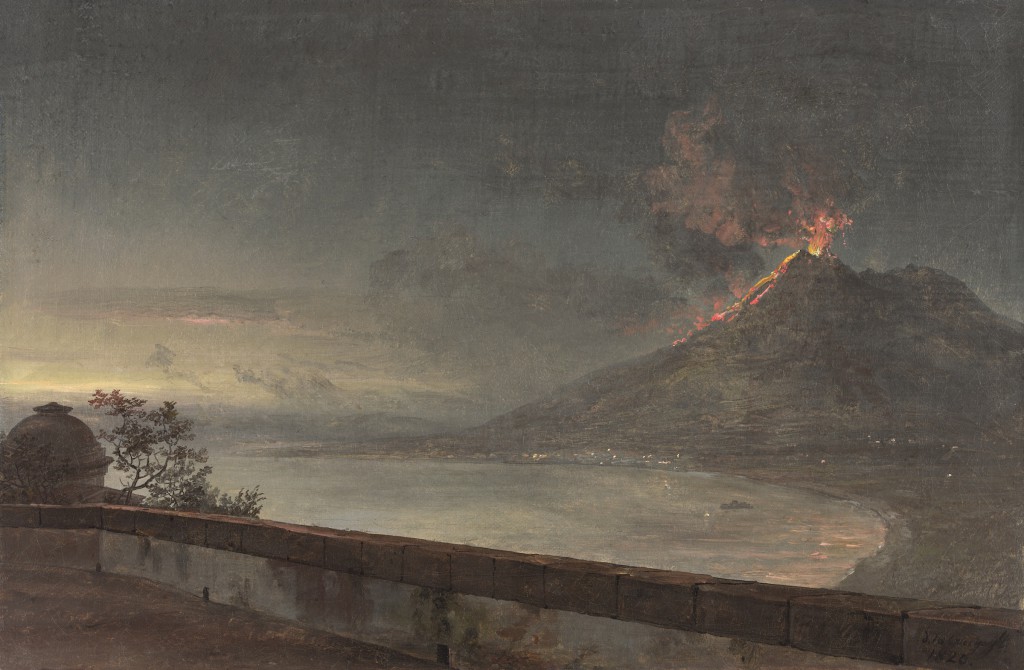Johan Christian Dahl, genannt Clausen-Dahl (Bergen 1788 - 1857 Dresden)
Blick von der Terrasse der Villa Quisisana über den Golf von Neapel auf den Vesuv, 1820
Öl auf Leinwand, 20,5 x 30,5 cm
Datiert unten rechts d. 16 August 1820
Provenienz:
General A. Bull
Oswald Berentzen, Oslo, 1920
Harald Aars, Oslo, 1937
Privatsammlung Norwegen, seit 1979
Literatur:
Bang, M.L., Johan Christian Dahl 1788-1857. Life and Works, Bd. 2, Oslo 1987, S. 102, Nr. 218
Ausstellung:
Katalog over Professor Dahl udstilligen, Christiania Kunstforening, 1907, Nr. 40
J.C. Dahl 1788-1857 Mindeutstilling, Oslo, Blomqvist Kunstutstilling, 1926, Nr. 90
J.C. Dahl’s verk, Minneutstilling, Oslo, Kunstnernes Hus, 1937, Nr. 123
Die wunderbare Abendstimmung mit Blick über die Bucht von Castellammare auf den ausbrechenden Vesuv im Hintergrund malte Dahl am 16 August 1820. Standpunkt für das kleine Gemälde war die Terrasse der Villa Quisisana, der Residenz des dänischen Kronprinzen Christian Frederik, des späteren König Christian VIII, während seines Aufenthalts in Italien. Mittels der signifikanten Kuppel der Palastkapelle die links über der Brüstung der Terrasse sichtbar wird, ist die Villa eindeutig zu identifizieren[1].
Die Einladung des Kronprinzen nach Italien erreichte Dahl im Mai 1820 in Dresden. Einen Tag nach seiner Hochzeit mit Emilie von Bloch im Juni 1820 verließ er die Stadt um nach kurzen Aufenthalten in München, Florenz und Rom am 11. August 1820 Neapel zu erreichen. Die ersten Monate seines Aufenthaltes verbrachte er auf Einladung des Kronprinzen in der Villa Quisisana[2].
Unser stimmungsvolles kleines Gemälde ist demnach sicherlich eines der ersten, wenn nicht das erste Gemälde, welches in der Villa entstanden ist. Es zeigt wie tief den Maler aus dem Norden die natürliche Schönheit des Golfes von Neapel mit dem aktiven Vesuv im Hintergrund beeindruckt hat und welch verschiedenartige malerische Möglichkeiten dem 32 jährigen nach seinem zweijährigen Aufenthalt in Dresden zur Verfügung standen. Seine Basis war die über viele Jahre an zahllosen Naturstudien gereifte Fähigkeit, natürliche Lichtsituationen wiederzugeben. Während die Terrassenmauer, die Kuppel und die Baumkrone im Vordergrund mit großer Detailgenauigkeit wiedergegeben sind hat der atmosphärische dunstige Hintergrund eher den spontanen Pinselduktus einer plein-air Studie.
In der Melancholie und Einsamkeit die das kleine Gemälde verbreitet, verschmilzt womöglich die Trauer über die Trennung von seiner frisch vermählten Frau mit dem Einfluss, den die Stimmungsmalerei seines bewunderten Dresdner Freundes Caspar David Friedrich in jenen Jahren auf ihn hatte[3].
[1] Die gesamte Anlage der Villa mit der Palastkapelle ist in einem Gemälde Dahls abgebildet, das auch die königliche Familie zeigt: J.C. Dahl, Quisisana von einer Terrasse aus gesehen mit Mitgliedern des Hofstaates, 1820/21, 93 x 136 cm, Museo Capodimonte Neapel, WVZ Bang, Bd.2, S.26; (fig. 1).
[2] Der Kronprinz hatte bereits 1815 noch während Dahls Studium in Kopenhagen damit begonnen den Künstler zu unterstützen.
[3] Helmut Börsch-Supan, Gegensätze in der Freundschaft J.C.Dahl und C.D. Friedrich, sh. Kat. 24, le Claire Kunst, Hamburg, 2009

